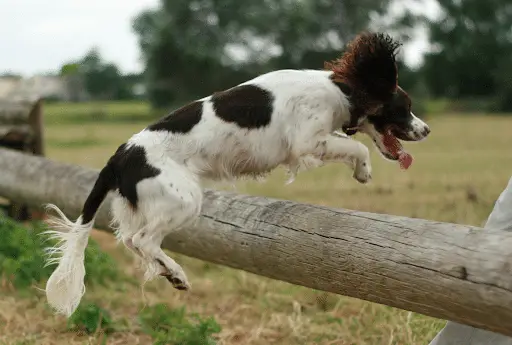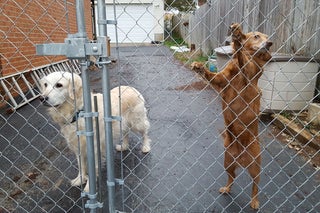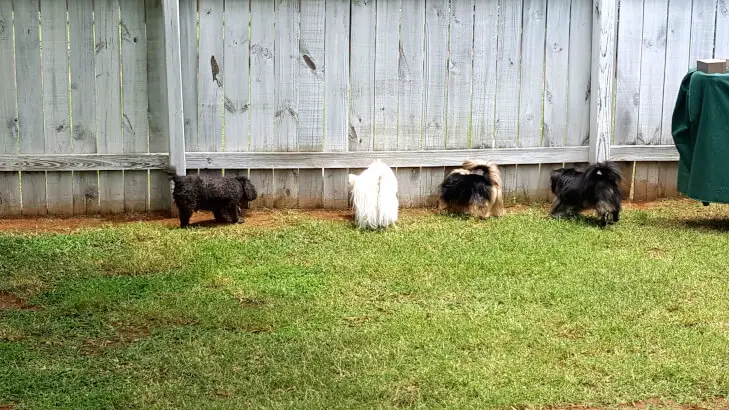Having a dog that has unlimited access to the backyard is excellent; it has lots of pros that we will discover later. And when you have a dog door, it makes your dog free to go to the backyard whenever he needs without any restrictions. But how do you prevent your dog from escaping the yard?
what if your dog sees a cat over the fence? Or a squirrel? What about pizza guy? What’s your dog’s reaction? And what if your dog isn’t trying to escape now, should you worry?
Preventing a dog from escaping the yard should be done by following several steps:
- Build a fence or extend the height of your fence
- Pour concrete under the fence (depending on how your dog tries to escape)
- Tire your dog throughout the day, so he won’t have the energy to try and escape
My Personal Experience With A Dog Escaping The Yard
A friend mine has had his amazing golden retriever for more than ten months now. I have been going to her home for more than eight months and training this amazing dog. He is a brilliant dog and never tries to do anything wrong at all and let me elaborate that they have one of the best bonds you can ever see.
He had unlimited access to the backyard where he could play and pee, and he would jump in your lab once you call his name from the other side of the house to get some rubies.
Furthermore, he started to make friends over the fence and neighbors fell in love with this handsome boy. We decided to leave a bag of treats on the fence so that anybody walking by can give him a treat for being a good boy.
Last month, he had reached ten months old already, and I received the shocking call (Soheir, can you please come over, I can’t find Mailo anywhere), and we were in the middle of a hurricane.
I jumped in the car, and we went to the store on the other side of the road and asked to see the camera logs and saw that he jumped over the fence and ran after a cat.
Yes, it is a nightmare. We are in the middle of the hurricane.
Going out in the streets is too hard for him and us. But we can’t leave him, can we? We had to call friends and split into three groups and found him hiding in a car parking to shelter or the rain. Now when we rewind, we have to keep in mind the following:
- Mailo has never chased any animal
- Mailo has never tried to disobey us
- Mailo is highly trained to walk off-leash and to protect his owner
So why did this happen? What triggers a dog to escape!?
What Triggers A Dog To Escape?
Before I write the usual list of the triggers that can force a dog to escape, I have to explain the philosophy of escaping.
Escaping isn’t usually a behavioral issue, but it’s an indicator of the existence of a behavioral problem. Dog’s escaping is typically a wake-up sign for the owner that says, “Be careful! Your dog is developing a new behavior.”
We can’t treat “Dog escaping,” but we need to manage the core behavior and understand why is he escaping? While we can do some temporary fixes to stop his ability to escape, but this doesn’t mean at all that he isn’t thinking of escaping.
Dogs can escape for a variety of reasons; each one of them represents a core behavior issue or a bond issue that we need to address individually and cure it:
| Issue | Description |
|---|---|
| Loneliness | Imagine staying in the backyard alone for 24/7? How does it feel? I will not shock you when I tell you that, according to AKC, 78% of the escaping dogs escape due to loneliness. Yes, it sounds pretty tragic. And you will realize it if you leave your dog alone all the time, so he has to escape to socialize with other people because they are “sociable creatures.” And you can read this fantastic article on how to fix loneliness. |
| Lack Of Exercises | Yes, they saw an excellent opportunity to play with the cat over the fence. Let’s have a good chase and burn some calories. |
| Lack Of walking | They want to explore everything around them in great detail, and they don’t have a chance, so they decided to go there alone to start sniffing and exploring the world. |
| Not enough trained | Until this time, Kira gets excited whenever she sees a jogger over the street (We will create an article about this soon, stay tuned), and she wants to go and play with him (NOT TO BITE HIM.) While honestly, some joggers here are pretty happy with this that they let her run with them to burn some energy, and this may be one of the happiest moments in her day. So your dog might be aroused by joggers, bikers, cats, pizza delivery guys, etc. Your best bet here is to train him by using the scenario-training method (This will be our next article.) Just creating a scenario where you have a jogger friend moving in front of your dog, and you try to train your dog not to run after him. And no, your dog won’t stop chasing on his own; you have to teach him. |
| Fear | The last thing is fear. Dealing with a scared dog is very hard and requires you to be patient and take things as slowly as possible. When dogs are afraid, they get in “Fight or Flight position.” And different dogs react to fear differently; for example, Kira starts to bite and growl when she is scared. She thinks that fighting is her way to defend herself against frightening things. Many dogs do unpredictable movements when they are afraid. I remember once, Kira was off-leash, and she heard a huge truck coming and using the horns very severely. She never ran off, but she decided it’s the right time for her to run-away and never thinks about me. So keep an eye on your dog, is he afraid of the neighbors’ dog? Is he fearful of the mailing van? Determine the cause of fear, and you can correct it quickly. |
| Adolescence period | This is the most annoying reason because it happens suddenly without any warning. Unfortunately, when dogs hit 9-10 months, they start to be “teenage dogs.” Teenage dogs “Adolescent dogs” are similar to human teenagers; they begin to be rebellious. Adolescent dogs are unpredictable, and no one can know their next move. That’s why you must know the correct way of dealing with them. Otherwise, you are most likely to face a hard time with your dog at this age. I’ve added a video of Zak George talking about the correct way of dealing with Adolescent dogs. |
| Other sources of excitement | Maybe your dog found a new source of confusion like food, an off-leash dog that he wants to play with, etc. To correct this, you need to address his excitement by teaching him that we won’t reach his aim except by following the rules. |
How do dogs escape?
There are mainly three ways a dog can escape the yard, and there is even a name for them:
The Jumpers:

Those are the dogs who start running so fast and jump the fence. This type is widespread if you train your dog agility training. Medium-sized dogs are trendy with this escaping, although some large-sized dogs who have a fabulous physique can jump high as well.
The diggers

Those are the dogs who dig beneath the fence. They are probably the larger and stronger dogs who are bored and need something to do to pass their time.
The genius dogs

They are the dogs who can open the fence gate; they are probably Huskies or Golden Retrievers who are very smart.
Identifying they type your dog is will indeed help you determine how to prevent him from escaping.
How to prevent your dog from escaping?
Now, after you have determined why and how your dog escapes, you have to start taking the next steps.
First, you have to prevent the dog from escaping physically. You can make it harder for your dog to escape by:
- Extending the height of your fence.
- Using Coyote Rollers: It’s a roller that prevents your dog from gaining the momentum by pushing against the fence as it will start rolling and make him slide.
- Remove anything that can help his jump
- Pour a concrete floor under the fence
- Block the view behind the fence: This is helpful if your dog is trying to chase a jogger or a biker.
- Increase the thickness of the fence if your puppy was so small that he could slip between the fence linings
- Use a double gate
- Exercise daily & give daily walks
- Never punish your dog for escaping
- If you can get him inside until he learns not to escape, then do it to keep him safe
Then, you have to look at his behavioral issues that we covered in the beginning to fix them, and later, he will no longer try to escape.
All of the above are some tricks to prevent him from escaping.
These are temporary fixes; the real fixed lies within the training and teaching your dog that escaping isn’t the right thing to do.
Even if your dog couldn’t escape from your yard, he could wait any chance to escape from you in the street. That’s why I prefer not to depend on physical solutions, but also to strengthen our bonds with our dogs.
What should I do if my dog escaped?
If your dog escaped and you chased him down. Please, never hit or yell at your dog. I know how hard it is to control your anger at this specific moment. However, be careful that that yelling may result in more escape accidents because he might start developing some fear against you.
So control your anger, don’t hit him, and don’t give him a treat. Just return home and calm down, then think about your next steps.
Does this mean backyards are bad?
Of course not!
Unfortunately, I don’t have a backyard, and I wish if I had had one! It’s an excellent place for training and off-leash playing.
Also, many people consider teaching their dogs how to pee there.
Backyards are also high energy burners if you used them correctly. That’s why I believe that terraces make your life with your dog much more comfortable if you used them successfully.
Conclusion
A backyard makes a beautiful place where you can have a great time with your dog. However, some dogs start developing certain behaviors that can trigger them to escape the yard.
Having patience will be your weapon to prevent your dog from escaping. Remember always to cure the behavioral issue and not only make escaping harder on your dog.
As always, stay tuned for our next article 😉

